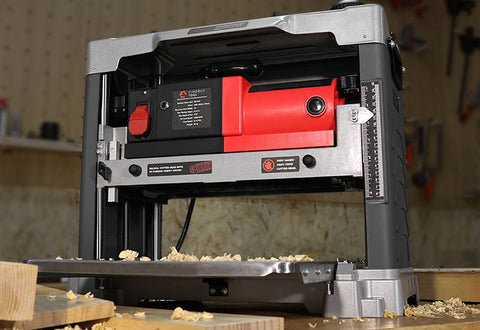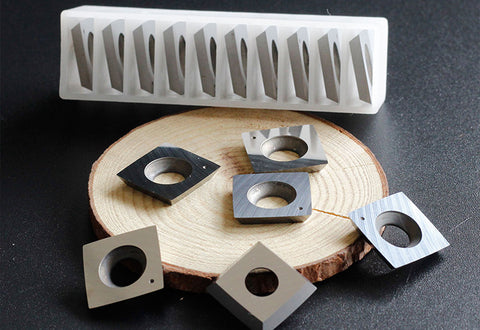Having lumber that is square and flat with faces and sides running parallel, makes any woodworking project go so much easier and smoothly. Planer and Jointer are two common and essential woodworking tools for preparing rough lumber to help you get flat and uniform wood to work with. These tools can help you create wood projects in any size or thickness that you want. Both of these tools come with a considerable cost, making them out of reach for many beginners or intermediate-level woodworkers who may not have either tool. But before you go and spend the money to buy one, it's important to know exactly what each tool is used for and how it works. With this article, we will attempt to explain what they’re used for exactly, the proper use of the jointer and the planer in planing rough-cut timber, and show that a jointer or a planer alone is insufficient.
What is a Jointer?
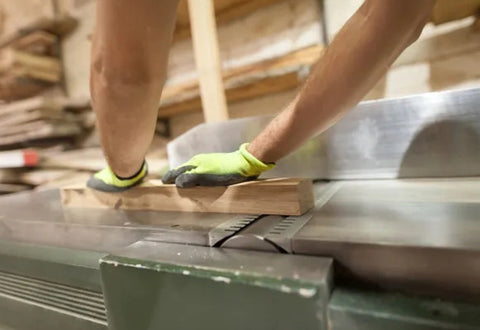
A jointer, also known as a surface planer or a planer in the UK, is a woodworking machine used to create flat, smooth, and straight surfaces on the faces and edges of lumber. It consists of an infeed table, an outfeed table, a rotating cutter head with multiple sharp knives or blades, and a fence.
The primary function of a jointer is to create a flat reference surface on the face of a board. This tool is particularly useful for ensuring that one side of a board is perfectly flat and that one edge is straight and at a perfect 90-degree angle to the flattened face. It removes any cupping, bowing, or warping, resulting in a smooth and even face.
However, a jointer is not designed to reduce the overall thickness of a board. Its purpose is to establish a flat face and straight edge but not to control the thickness of the board. Furthermore, jointers don't ensure both faces of a board are parallel. In such cases, a planer or additional milling operations are required.
Another point to consider, a planer can create an S4S wood board, while a jointer can not do it. The inability of a jointer is primarily due to its reliance on the flat table as a reference surface. When a board is passed through a jointer, only the portion of the board that is in contact with the table will be cut. This can result in uneven removal of material across the surface, leading to a board that is not uniformly flat or of consistent thickness. For achieving S4S lumber with consistent thickness and parallel faces, woodworkers typically use a combination of tools like a jointer, planer, and possibly a table saw or jointer-planer combo to achieve desired results.
What is a Planer?
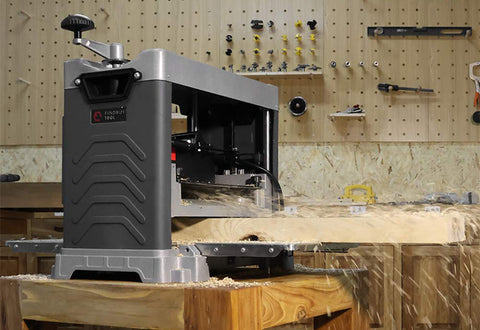
A planer, also known as a thickness planer, is a woodworking machine used to reduce the thickness of lumber and create uniform thickness and smooth surfaces on a board that has already been partially flattened. The planer consists of an outfeed table, and an infeed table, between which a rotating cutter head is positioned. As the material passes through the planer, the rotating cutter head, equipped with multiple knives or blades, removes a thin layer of material from the top surface of the wood as it passes through the planer. The bed can be vertically adjusted to control the thickness of the material being planed.
The planer is particularly useful when you need to make things perfectly parallel or achieve consistent thickness. It removes material from the top surface of the board, ensuring that it is uniformly thick from end to end with multiple passes. Therefore, planers are essential tools for achieving precise dimensions and uniform thickness in woodworking projects. By processing rough lumber effectively, they save woodworkers time and effort when compared to hand planing or sanding, resulting in usable boards with smooth, parallel surfaces.
However, while a planer is a versatile tool, there are some limitations to what they can achieve. A planer is not designed to straighten or joint the edges of a board. For edge jointing, it’s common to employ a jointer. In addition, while a planer can make both faces of a board parallel, it cannot flatten a warped, twisted, or cupped board. Usually, hand planes or a jointer are used for the initial flattening.
What are the Differences: Planer and Jointer
Both the jointer and the planer are essential tools in woodworking, each serving distinct purposes and specific functions. Here are the primary distinctions between a planer and a jointer.
Cutterhead position
Jointer: The cutterhead of a jointer is mounted underneath the wood board. As they rotate upwards, the blades or knives make contact with the bottom surface of the board.
Planer: The cutterhead of a planer is mounted above the board. As they rotate downwards, the knives or blades make contact with the top surface of the board.
Functions and capabilities
Jointer: First of all, a jointer can flatten a surface and it can straighten an edge, but it cannot make two surfaces or two edges parallel to each other. You can run the board through a planer to get a consistent thickness board across both faces.
Planer: While a jointer can address surface irregularities due to the manner in which they grind down the bottom side of a board, a planer alone cannot remove bows, twists, or cups. A planer is more suitable for achieving consistent thickness and parallel faces on already flattened and straightened lumber, rather than removing initial imperfections.
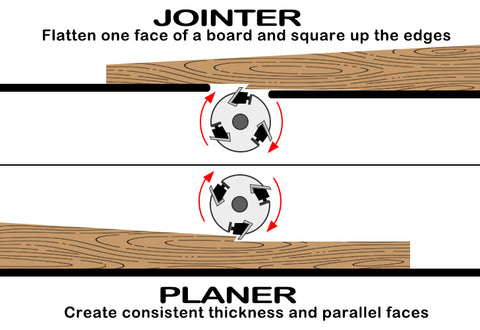
Size and shape limitations
Jointer: For the sizes of jointer, 6" and 8" are predominate. Jointers are typically limited by the width of their bed. Boards wider than the bed cannot be flattened using a jointer, so larger boards may require alternative methods.
Planer: Planers are usually 12" to 13", with larger machines available. Planers can handle wider boards compared to jointers. However, the thickness capacity and the amount of material that can be removed in a single pass are limited.
Usage sequence
Jointer: In woodworking projects, the jointer is generally used first to create a flat reference surface and square up one edge on the board.
Planer: Following the jointer, the planer is then used to bring the board to its final thickness and smoothness, ensuring that both faces of the wood are parallel with a consistent thickness.
Why You Might Need a Jointer-Planer Combo
As we mentioned earlier, both tools serve distinct purposes in the woodworking process, but they play a great role in handling rough lumber. Whether to buy a jointer or a planer first depends on your specific woodworking requirements, budget considerations, project priorities, and long-term goals. If your primary concern is dealing with rough and uneven lumber, removing twists, bows, and cups on a piece of wood, or achieving a flat reference surface and square edges, a jointer might be the more suitable initial purchase. However, if your focus is on making a board uniform in thickness with two parallel surfaces, or working with pre-surfaced boards, a planer might be the better option.
So in order to create a board that is perfectly straight, flat, and of uniform thickness, that is why you might need a jointer-planer combo. A jointer-planer combo, as the name suggests, is a versatile woodworking tool that performs the functions of both a jointer and a planer. Typically, the jointer component is mounted on top of the machine, with the planer directly underneath. Jointer-planer combo machines offer space efficiency, cost savings, and versatility, making them a practical choice for many woodworkers.
Final Thoughts
In conclusion, a jointer and a planer serve different purposes but have an important place in woodworking. Consider your project requirements, budget, and the sequential use of a jointer and planer to make an informed decision. If you choose to purchase a thickness planer, make sure to start by checking our website page. Findbuytool wood planers offer you board thickness with precise measurements. FindBuyTool sells 2 cost-effective thickness planers: FindBuyTool FB131H and FindBuyTool FB131. FindBuyTool FB131H comes with a pre-installed 4-row helical cutter head and 40 indexable carbide inserts, eliminating the need to install it yourself. FindBuyTool FB131 comes with 3 HSS blades, also eliminating the need for self-installation.

